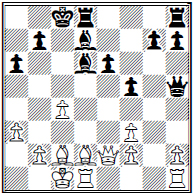White: Ivanov, Alexander (2615)
Black: Bradford, Joseph (2414)
[C03] French, Tarrasch
U.S. Senior Open,
Boca Raton, Florida 2010
1.e4 e6 2.d4 d5 3.Nd2 a6 4.Bd3 [4.Ngf3 c5 (4...Nf6) ] 4...c5 5.dxc5 Nf6 6.exd5 This move is less popular than [6.Qe2 or; 6.Ngf3 but we were following the game Ivanov-Shulman, USA Championship 2006] 6...Qxd5 7.Ngf3 Bxc5 8.Qe2 Nbd7 9.a3N This is a novelty. Against Shulman I played 9.c4, but didn't get much out of the opening. Also known is [9.Ne4 b5 10.0-0 Bb7 11.Nxf6+ gxf6!?= Rublevsky-Volkov 2005] 9...Bd6!? Black is preparing Ne5. After the natural [9...0-0 White can try 10.0-0 and if 10...b5 then 11.b4 Ba7 12.Bb2+/=] 10.c4?! This and White's next move don't go well together. The immediate 11.Ne4 was probably better, hoping to win time by attacking the black Queen with pieces and saving c4 for later. 10...Qh5 11.Ne4 [11.b4 Ne5=] 11...Nxe4 12.Bxe4 Ne5?! Black is too eager to trade pieces. [12...Nf6 13.Bc2 Bd7=] 13.Bd2 This stops the possible Qa5+, but allows Black's next strong move which compromises both sides' Pawn structures. White had two ways to get a plus. First the simple [13.Nxe5 Qxe2+ 14.Kxe2 Bxe5+/= I wasn't sure whether White could convert the advantage here. Then the computer move; 13.Bf4 Nd3+ (13...Nxc4 14.Qxc4 Bxf4 15.Bc6+! bxc6 16.Qxc6+ Ke7 17.Qxa8+/-) 14.Qxd3 Bxf4 15.Qd4 f6 (15...0-0 16.Bxh7+ Qxh7 17.Qxf4+/=) 16.0-0 Bc7 17.Rfd1 0-0 18.c5+/=] 13...f5 14.Bc2 [14.Bc3?! Ng6 looks too messy (14...Nf7!?) ] 14...Nxf3+ 15.gxf3 Bd7 [15...0-0 16.0-0-0+/=] 16.0-0-0 0-0-0 [16...0-0? 17.Qd3+-]

17.Ba5!+/= My opponent said after the game that he overlooked this move. I like it more than [17.Bc3 Qh6+ 18.Kb1 Bc7 unclear] 17...Bc7?! Other options are [17...Qh6+ suggested by Bradford as an improvement; still White is better after 18.Kb1 Bc7 19.Bxc7 Kxc7 20.Qe5+ Kc8 21.Rd6 Qf6 22.Qc5+ Kb8 23.Rhd1 Rc8 (23...Bc8 24.Bxf5!+-) 24.Qe3+/-; 17...Bf4+ probably the best 18.Kb1 Rde8 19.Rd4!? e5 20.Rxd7! Kxd7 21.Qd3+ Ke7 (21...Kc8 22.Qd6!+-) 22.Qd5 with initiative] 18.Bxc7 Qh6+ [18...Kxc7 19.Qe5+ Kc8 20.Rd6 Qxf3 21.Rhd1+/- and 21...Qxf2 loses to 22.Rxd7 Rxd7 23.Qxe6+-] 19.f4 Kxc7 20.Qe5+ Kc8 21.Rd6+/- Qf6 Black has nothing better. 22.Rhd1 Qxe5 23.fxe5 g5 24.b4! [Less convincing is 24.c5?! Kc7 25.Bb3 Rhe8 and it's harder for White to advance his Queenside Pawns] 4...Kc7 [24...Rhe8 25.R1d3 g4 26.Bb3 h5 27.b5+/-] 25.a4 Bc8 [25...h5 26.b5 axb5 (26...g4 27.b6+ Kc8 28.c5+-) 27.axb5 b6 28.c5+-] 26.b5 Rxd6 Avoiding the exchange also loses [26...axb5 27.axb5 b6 28.c5!+-] 27.exd6+ Kd8 28.c5 Bd7 29.Bd3?! [29.bxa6 bxa6 30.Kd2 Bc6 31.Rb1 Kd7 32.Rb6+- was winning easily] 29...axb5 30.axb5 Kc8 [30...e5 This counterplay is insufficient; White’s connected passers are too strong. 31.Kd2 e4 (31...Kc8 32.Ra1 Kb8 33.Kc3 g4 34.Bc4 h5 35.Bd5! Rc8 36.Kb4 h4 37.Rc1+-) 32.Bc4 Kc8 33.Ra1 Kb8 34.Kc3+-] 31.Re1?! Again a little too cautious [31.Kd2 Kb8 32.Rb1 Rc8 33.c6 I saw this idea, but was afraid to lose all three Queenside Pawns for the Bishop. 33...Bxc6 34.bxc6 Rxc6 35.d7 Rd6 36.Rb6!+- Unlike us humans computers don't miss such tactics. (36.Re1? Kc7+/=) ] 31...Kb8 32.Kd2 Rc8 33.Re5 h5 34.Ke3 h4 35.Kd4 g4 36.Bc4 [36.Ke3] 36...Re8 37.Ke3 [37.c6 bxc6 38.bxc6 Bxc6 39.Bxe6+-] 37...f4+? Black's last hope in time trouble was [37...Rg8 38.Bxe6! (38.Kf4? g3 39.fxg3 Rg4+-+ since Bc4 is hanging; 38.Be2 g3 39.fxg3 hxg3 40.hxg3 Rxg3+ 41.Kf4 Rg1 42.Bh5+/-) 38...Re8 39.Bxd7 (39.c6 bxc6 40.bxc6 Bxe6 41.Kf4!+- Kc8 42.d7+ Bxd7 43.cxd7+ Kxd7 44.Rxe8 Kxe8 45.Kxf5+-) 39...Rxe5+ 40.Kd4+-] 38.Kxf4 Rf8+ 39.Kxg4 Rxf2 40.h3 Now it's over. 40...Rc2 41.Bxe6 Bxb5 42.Kxh4 Rd2 43.Rd5 Rc2 44.d7 1-0
|